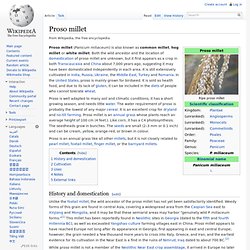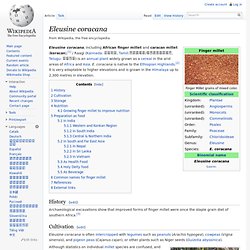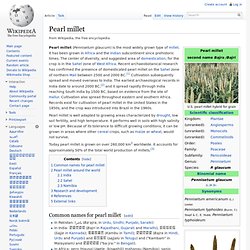

Millet. Millets are a group of highly variable small-seeded grasses, widely grown around the world as cereal crops or grains for fodder and human food.

Millets are important crops in the semiarid tropics of Asia and Africa (especially in India, Mali, Nigeria, and Niger), with 97% of millet production in developing countries.[1] The crop is favored due to its productivity and short growing season under dry, high-temperature conditions. The most widely grown millet is pearl millet, which is an important crop in India and parts of Africa.[2] Finger millet, proso millet, and foxtail millet are also important crop species.
In the developed world, millets are less important. Paspalum scrobiculatum. Paspalum scrobiculatum, Kodo millet, is an annual grain that is grown in primarily in India, but also in the Philippines, Indonesia, Vietnam, Thailand, and in West Africa where it originates.

It is grown as a minor crop in most of these areas, with the exception of the Deccan plateau in India where it is grown as a major food source.[1] It is a very hardy crop that is drought tolerant and can survive on marginal soils where other crops may not survive, and can supply 450–900 kg of grain per hectare [2] Kodo millet has large potential to provide nourishing food to subsistence farmers in Africa and elsewhere. Description[edit] Kodo millet is a monocot and an annual grass that grows to heights of approximately four feet.[3] It has an inflorescence that produces 4-6 racemes that are 4–9 cm long. Its slender, light green leaves grow to be 20 to 40 centimeters in length. Proso millet. Proso millet (Panicum miliaceum) is also known as common millet, hog millet or white millet.

Both the wild ancestor and the location of domestication of proso millet are unknown, but it first appears as a crop in both Transcaucasia and China about 7,000 years ago, suggesting it may have been domesticated independently in each area. It is still extensively cultivated in India, Russia, Ukraine, the Middle East, Turkey and Romania.
In the United States, proso is mainly grown for birdseed. It is sold as health food, and due to its lack of gluten, it can be included in the diets of people who cannot tolerate wheat. Proso is well adapted to many soil and climatic conditions; it has a short growing season, and needs little water. Eleusine coracana. Eleusine coracana, including African finger millet and caracan millet (koracan),[1] / Raagi (Kannada: ರಾಗಿ, Tamil:இராகி/கேழ்வரகு, Telugu: రాగి) is an annual plant widely grown as a cereal in the arid areas of Africa and Asia.

E. coracana is native to the Ethiopian Highlands.[2] It is very adaptable to higher elevations and is grown in the Himalaya up to 2,300 metres in elevation. History[edit] Archaeological excavations show that improved forms of finger millet were once the staple grain diet of southern Africa.[3] Cultivation[edit] Eleusine coracana is often intercropped with legumes such as peanuts (Arachis hypogea), cowpeas (Vigna sinensis), and pigeon peas (Cajanus cajan), or other plants such as Niger seeds (Guizotia abyssinica).
Finger millet Although statistics on individual millet species are confused, and are sometimes combined with sorghum, it is estimated that finger millet is grown on approximately 38,000 km2. Storage[edit] Nutrition[edit] Protein 7.6g Fat 1.5g Carbohydrate 88g. Pearl millet. Pennisetum glaucumMHNT Pearl millet (Pennisetum glaucum) is the most widely grown type of millet.

It has been grown in Africa and the Indian subcontinent since prehistoric times. The center of diversity, and suggested area of domestication, for the crop is in the Sahel zone of West Africa. Recent archaeobotanical research has confirmed the presence of domesticated pearl millet on the Sahel zone of northern Mali between 2500 and 2000 BC.[1] Cultivation subsequently spread and moved overseas to India. The earliest archaeological records in India date to around 2000 BC,[2] and it spread rapidly through India reaching South India by 1500 BC, based on evidence from the site of Hallur.